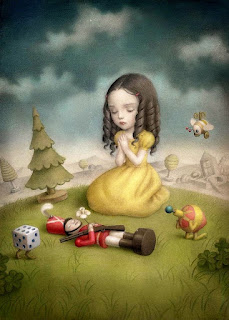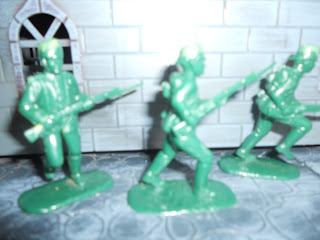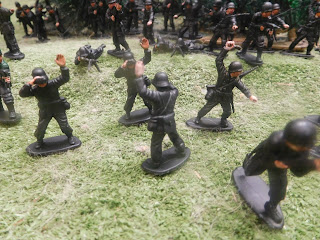The Dutchy of Tragardland, Frank Perry, Inspirations For Wargaming And A Sad Picture Of A Deceased Toy Soldier
Occasionally I mention other people's blogs because one thing so fantastic about the Internet is the community of likeminded hobby people. The Duchy of Tradgardland is one such blog. Anyone who creates imagi-nations is a friend of mine. If you click onto this blog you will find other links to his additional related blogs as well as other people's ones. The recent post was about old plastic Warrior articles starring Frank Perry, one of the great inspirations in my own gaming.
Several influences contributed to my own toy soldier voyage. First of all, there is my very nostalgic 196Os childhood. Playing with toy soldiers was a big part of it, either in solo games or with a friend, usually Pete Smith. The game rules were very simple but included set distances for moving ONE figure per move and launching various projectiles from the position of an individual figure. Most of the figures were plastic made in England, cereal packet or Hong Kong. There was also a handful of hollowcast Britains British redcoats given to me by Aunty Elva and Uncle Ken Clarke's sons, Graeme and Pete. (These same relatives saved all the cereal figures and cards for me).
The second phase was discovering Airfix kits and figures, especially the catalogue with painted versions of their MODEL soldiers. As I entered teenagerhood it was important to not call them toys! I also read all the books, on the topic, in the school library. I studied the painting techniques. Those books were among the most important part of my Tech school years. I might stuff up my woodwork models - I usually ended up with the class model - but I could paint toy soldiers. I had been, since about the age of ten, fluffing about painting the odd cereal figure with a limited palette of house paints and the occasional Airfix and Humbrol enamel. But I got more serious about it in my teens and beyond. I even had shadow-shelves, on my wall, with figures I had painted.
But wargaming was a bit hit and miss. I was past throwing marbles at soldiers in the garden. I bought an Airfix book on ACW gaming and collected and painted Airfix HO figures (as well as the 1/32 ones). I had the Union army and Pete had the Confederate, strange, as in later life I switched to the Confederacy. I did a fairly good job converting and painting them, but we never really worked out the rules!
Meanwhile, my old childhood 54 mm toy soldiers languished in boxes under my bed, still loved but not played with.
Several things happened in the later 1970s and 1980s. I bought Frank Perry's First and Second Books of Wargaming and, by a happy accident, I found out, in the 80s, about Plastic Warrior magazine and ACOTS (or Australian Collectors of Toy Soldiers). Both of these were dedicated to 54mm toys soldiers (mostly plastic) and to PLAYING with them. Bob Bolton and Brenton Hoffman, in Adelaide wargamed on an epic scale with regiments of 24 infantry and 12 cavalry per unit but, all up, hundreds, even thousands of figures on beautifully landscaped tables. We also wargamed, on Alan Cosey's floor in Melbourne. An annual convention, every Easter, ensued. One day was devoted to swap meet and another to wargames. Our numbers began at less than a dozen and grew to the larger numbers we have today.
This also meant that the old toy soldiers came back out of their boxes. The second thing is I began, at the other ACOTS members' suggestions, painting UNITS of figures. This swiftly became ARMIES of hundreds, even thousands, initially ACW and then medieval followed by others.
The ACW rules were influenced by Donald Featherstone and largely limited to one or two pages.
With Steve Wardle joining we also had some new rules based on each figure rumbling with the adjacent one to occupy his space if he 'killed' him. Steve is well known for his massive collection, especially of his medieval armies, and painting skills as well as his skilled wargaming.
Getting back to Frank Perry and son Ross I was very impressed by the lovely black and white photos in Frank's books, pictures of simple block buildings, hollowcast and plastic English made figures. The Plastic Warrior articles on the same impressed me very much. I posted on this, in my blog, some time ago but what I liked was how Frank invented countries, often with technology and uniforms from different eras or fictitious. There was an SF assumption underlining all of this, one which I have continued in my own fantasy games. The original reason was that Frank had to game with what was available. Cowboys and Indians could end up fighting Highlands and British 'ceremonial' troops, not to mention WW1 and WW2 and later. I especially liked the account of ancient Egyptians smothering the crew of a WW1 tank by sitting on it and an archer shooting a helicopter pilot!
Added to these influences were those of my students who painted and played with Games Workshop Warhammer figures. By the 1990s I had a large SF Space Ork army. I also acquired the Warhammer rules books. These latter infiltrated my 54mm fantasy games, as did a set of rules called Chainmail.
Another big influence was Paul Wright with his Funny Little Wars books. Paul inspired me to create imagi-nations armies for the Victorian and Edwardian eras. Paul's books are, in turn, influenced by HG Wells 1913 book, Little Wars (as was Frank Perry).
One of my great advantages is having a wargaming pal living in the same street. I seldom have to transport figures and scenery. Mat comes over and we wargame on my tables and sometimes in the garden). My tables are table tennis ones with addons from smaller tables and covered in artifical lawn grass. They are permanently set up in the games room and garage, although one of them is almost always covered with toys soldier related projects and STUFF.
Today I came across, on Facebook, a toy soldier related piece of art. Scott Lesch had shared it. (I forgot to mention the many toy soldier sites on FB, including an ACOTS one and my own, 'Fantasy and SF conversions and Wargames in 1/32'. I must be a member of ten different toy soldier FB sites).
SO here it is:
I don't know the artist but the picture is very evocative. It has a kind of Alice in Wonderland look. It made me think of three things, one being more whimsical. Firstly is the 'death' of toy soldiers. When I play my campaign soldiers are 'casualties'. But not all 'die'. Between one quarter and on half 'come back' as they recover from wounds, Sadly, this does not happen if the whole unit is wiped out. I often think about the plastic bereft widows and children. In reality all the actual figures come back into play in another game, eventually. Characters can 'die' two or three times before they are permanently erased. The figure is still there and might receive a new name and personality, but the character is gone, recorded, however, on my blog for posterity.
Another consideration is that figures can get damaged. Many of the old plastics I once played with are now retired to boxes or display shelves as the plastic has become brittle with age. Even there they can face mishaps, as when I recently moved a cabinet and a wooden shelf collapsed and broke three or four Lone Star Indians and a painted Airfix space warrior. The use of chalk in the molds, extremes of temperature and general chemical decomposition take their toll. Once they were marketed as 'indestructible'. This does not happen to all figures. The Hong Kong copies of made in England figures are, ironically, less prone to such deterioration. The polyvinyl Britains Detail figures also are much tougher, and perhaps closer to the description, indestructible. The old hollowcast metal figures, frequently, have endured much rough handling by children. They have lost the odd arm and have the odd dint. Some are subject to lead rot. Generally, however, they have survived and come back to life (assuming they are not astonishingly valuable - and the majority of battered ones are not) when given new parts and a nice new coat of paint.
Lastly, sad to relate, are the death of the metaphorical toy soldiers - wargamers and collectors. Frank is no longer around. A great friend of mine, Dave Bryant, who lent me his homemade molds and gave me stacks of toy soldiers and parts, went to the toy soldier castle in the sky several years ago. ACOTS has lost some of its members, such as the beloved 'Tinny' and, recently, Garry Mansfield, among others. Some other former members have just vanished into the wilderness.
Anyhow, that is my rambling article for today. Thanks, if you got through to the end!










sadly the impermanence of things has really gotten my attention. a lot of deaths in our family over the past several years, and our move, homelessness and loss of personal goods...well, it's sad, but it's also a new start....
ReplyDeleteThe memories are still there.
DeleteEven those friendships may be impermanent.
DeleteNicoletta Ceccoli is most likely the artist of "a prayer for a toy soldier".
ReplyDeleteOr, then again the work might be by Mark Ryden! Very similiar styles.
ReplyDeleteThanks. I do love the whimsical and exaggerated style.
DeleteA post making time for some afterthought. I't was my late friend Morten who actually gave me the idea and spark to get into this in the first place. Unfortunately ha passed away before we got into gaming.
ReplyDeleteAnother aspect of casualties and 'kills' in games. I've played majority of my games with UN troops. I hve several friend who have been into UN service. A lot of others I know have returned from their service with invicible wounds. This kind of things makes me think, when my UN wargaming units takes hits....
Yes, the little toy soldiers are representing real people (unless they are fantasy). On the other hand, as HG Wells said, we should put all the world leaders and generals in a room with toy soldiers, so they don't kill any real people.
DeleteA thoughtful and interesting post. Thanks for the mention, most kind.
ReplyDeleteAlan Tradgardland
Your and our biography through toy soldiers. Interesting read as ever. JOC.
ReplyDelete